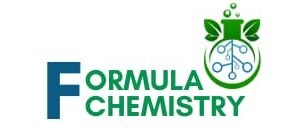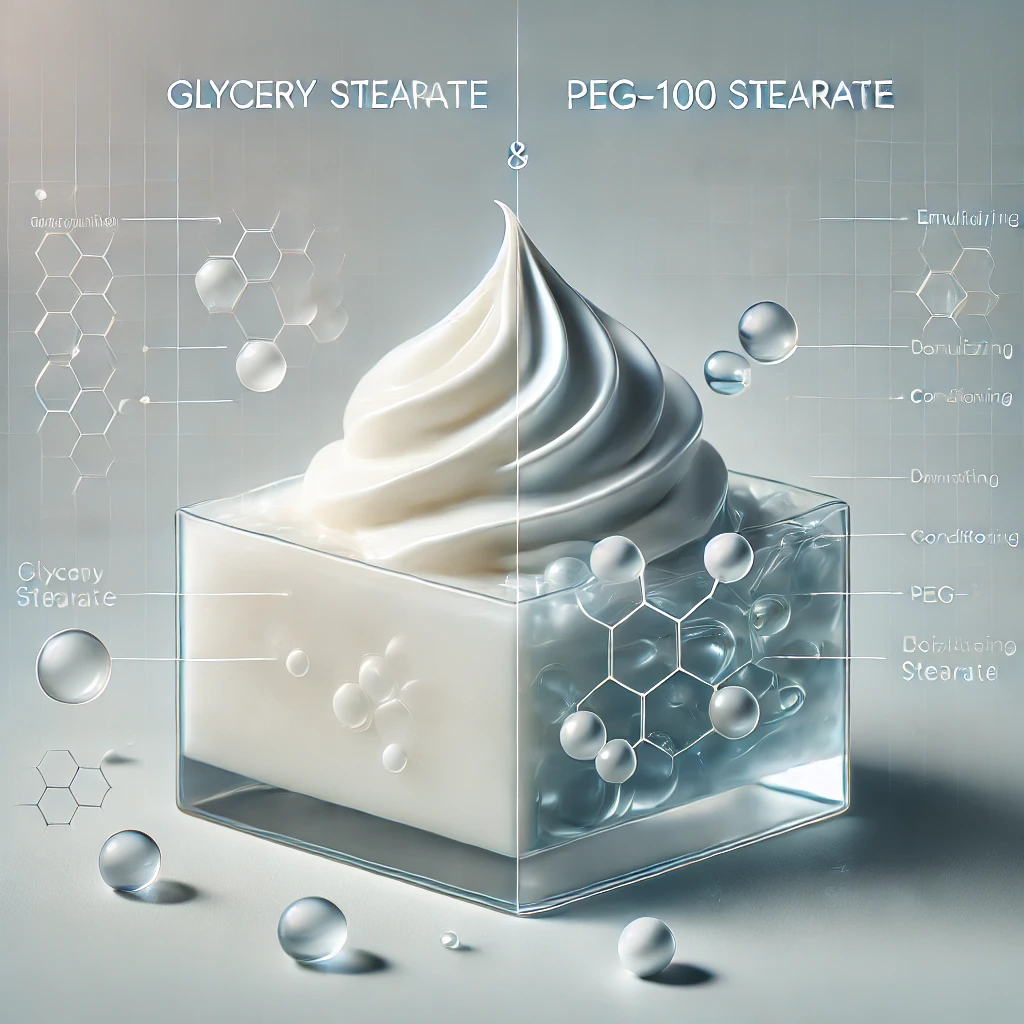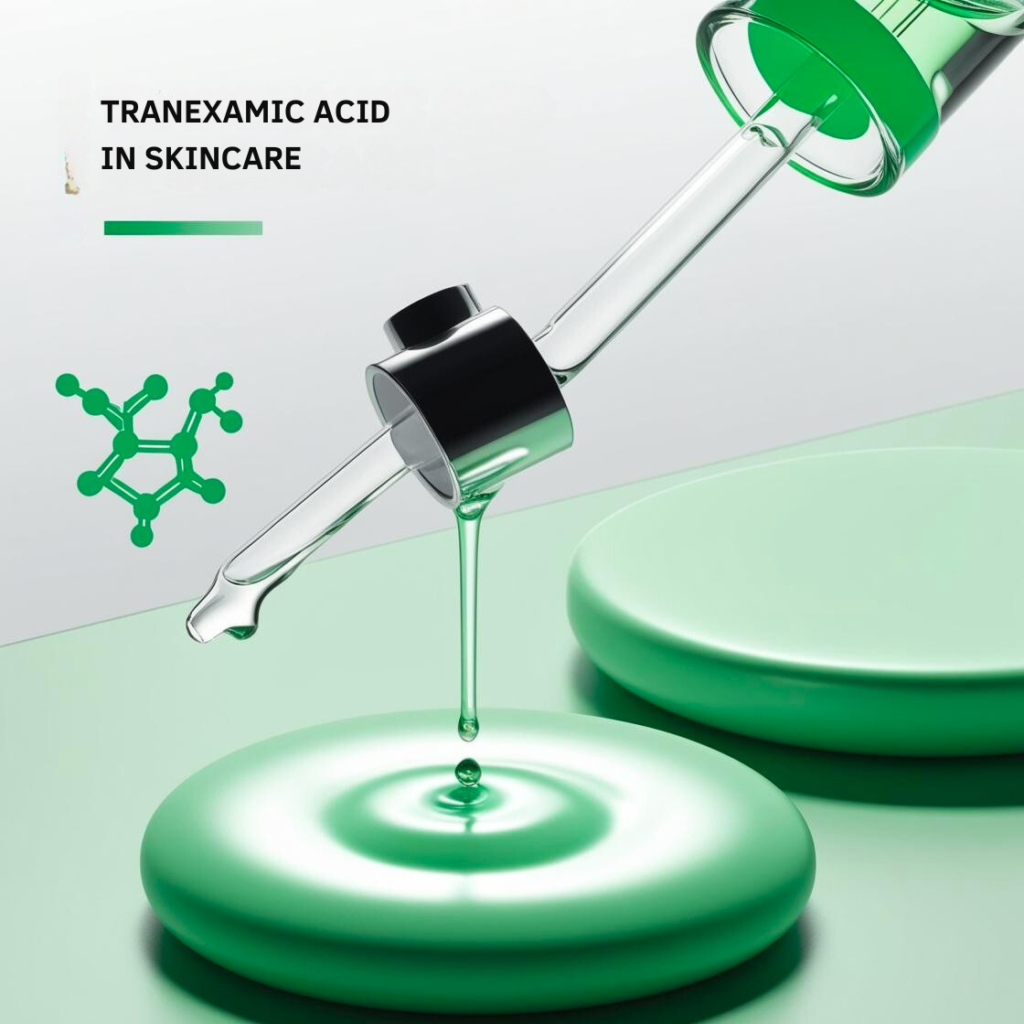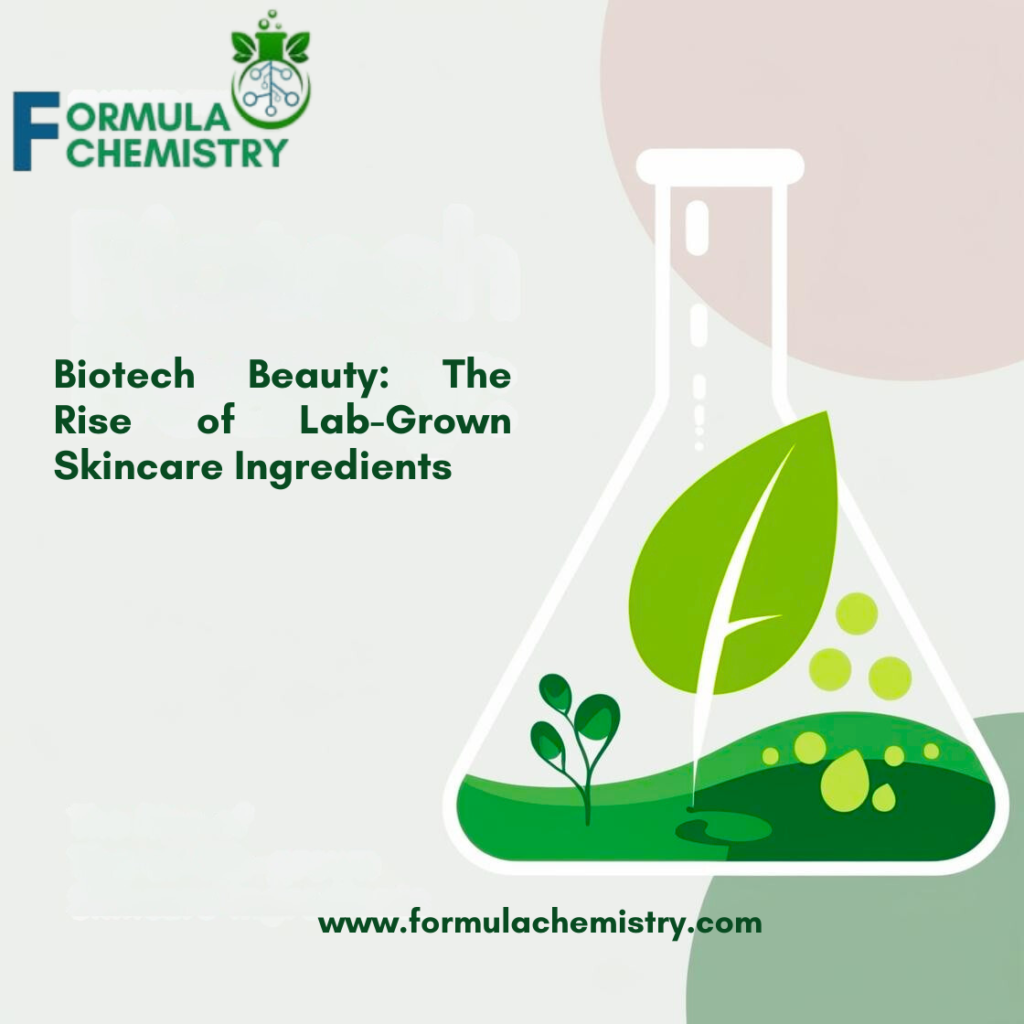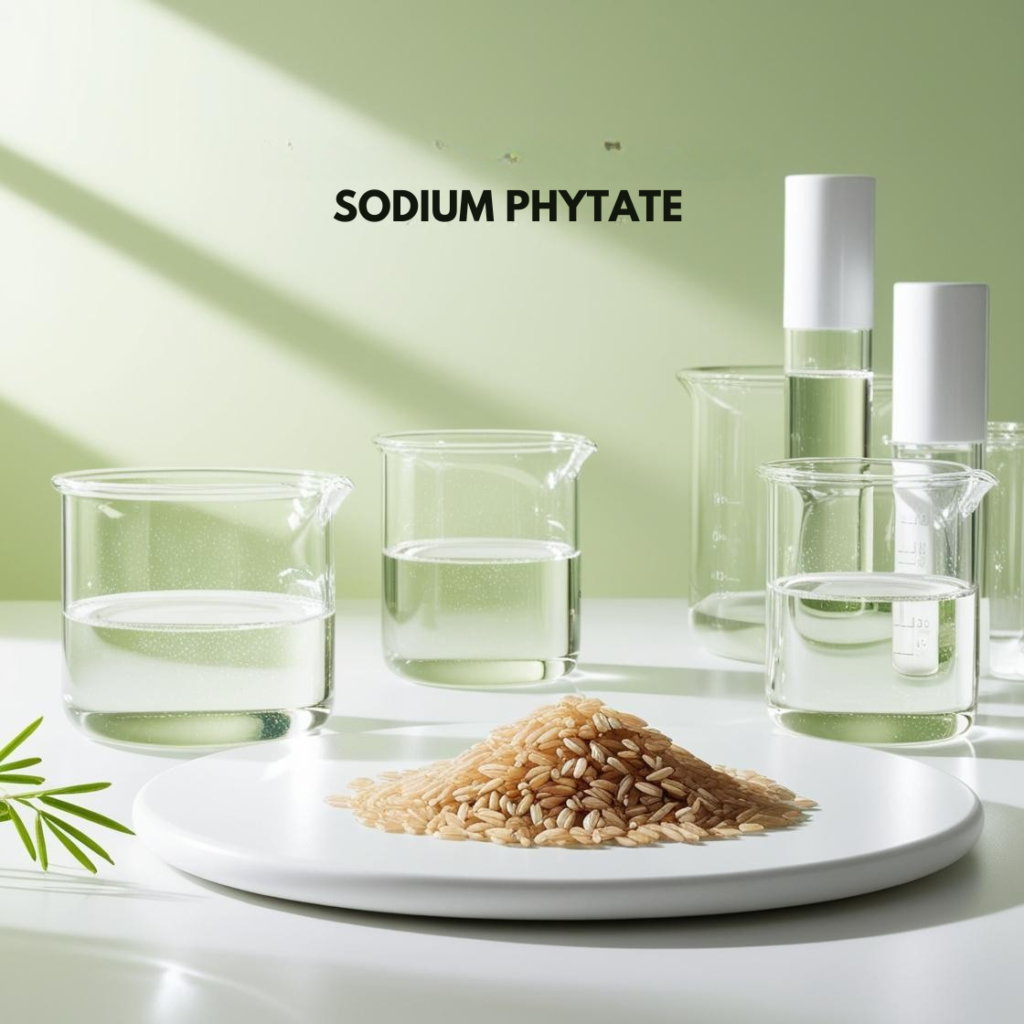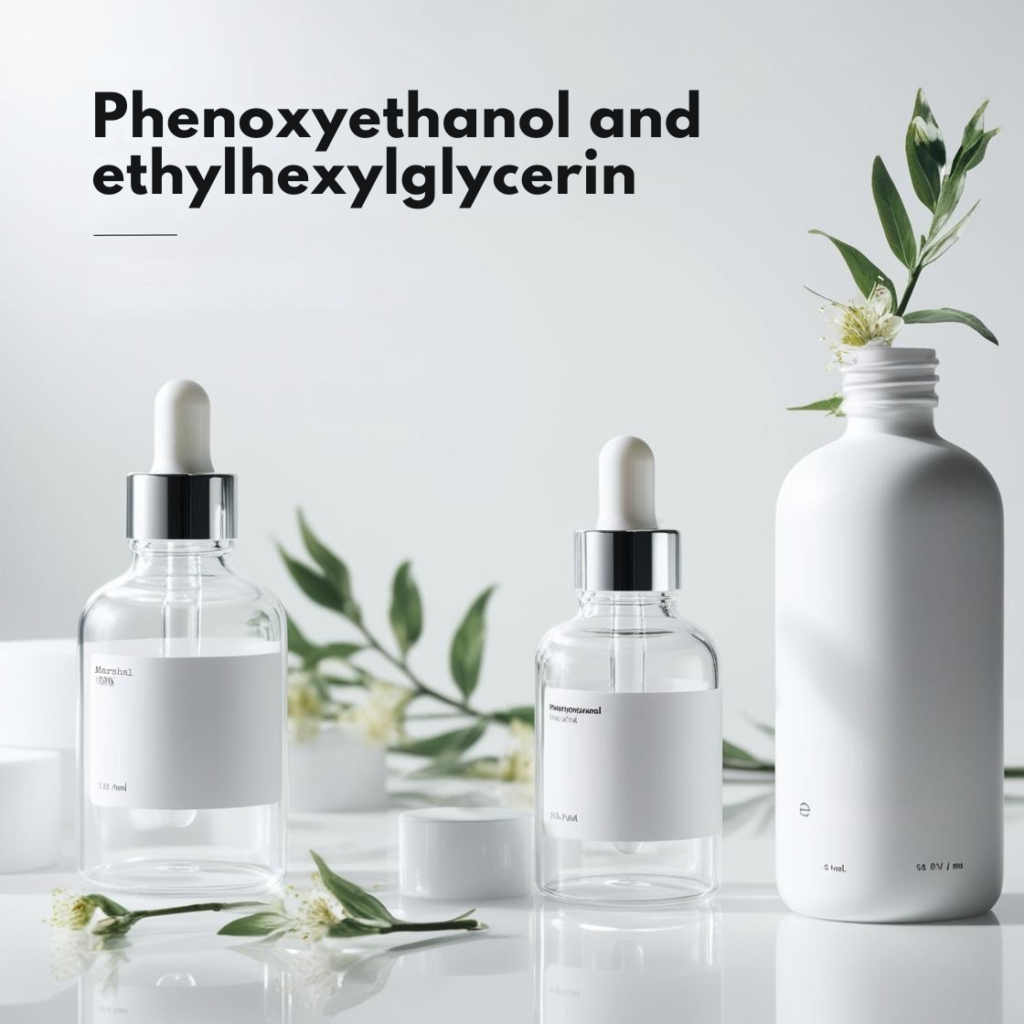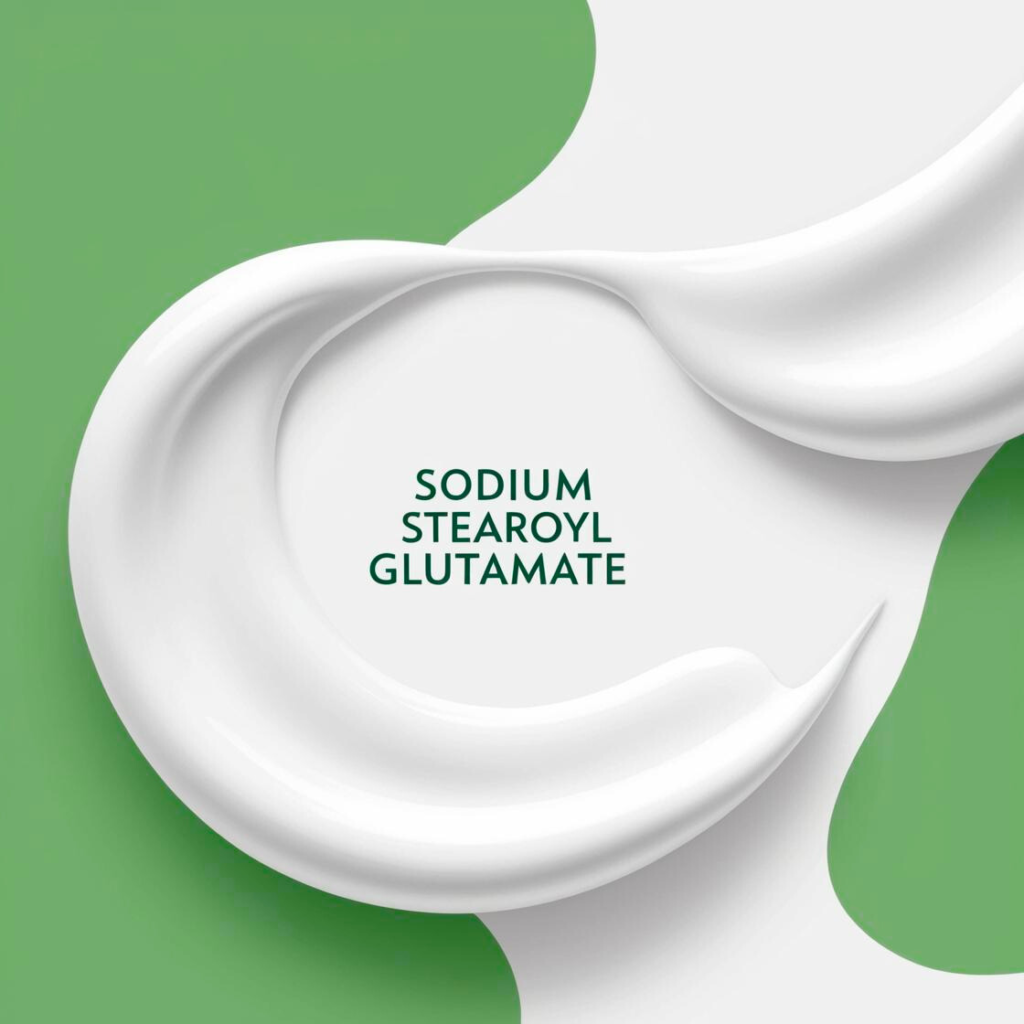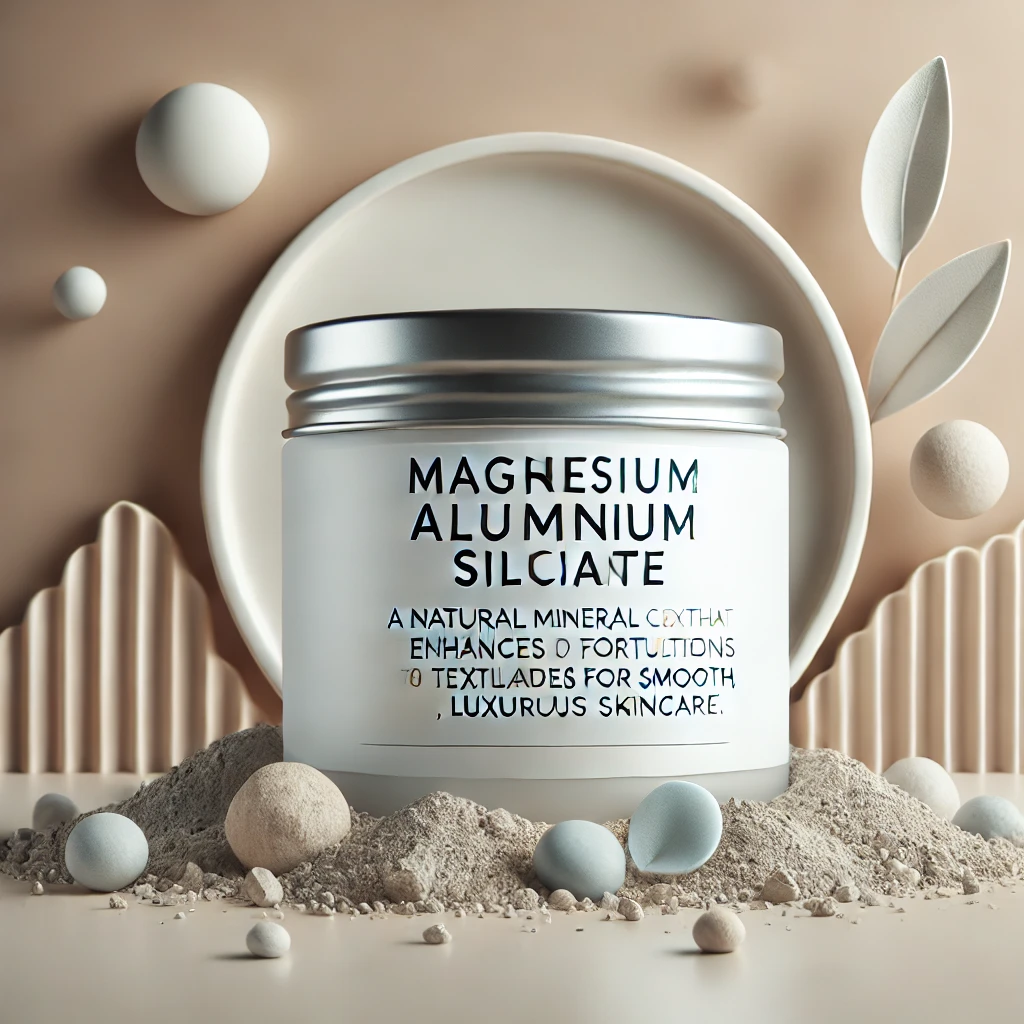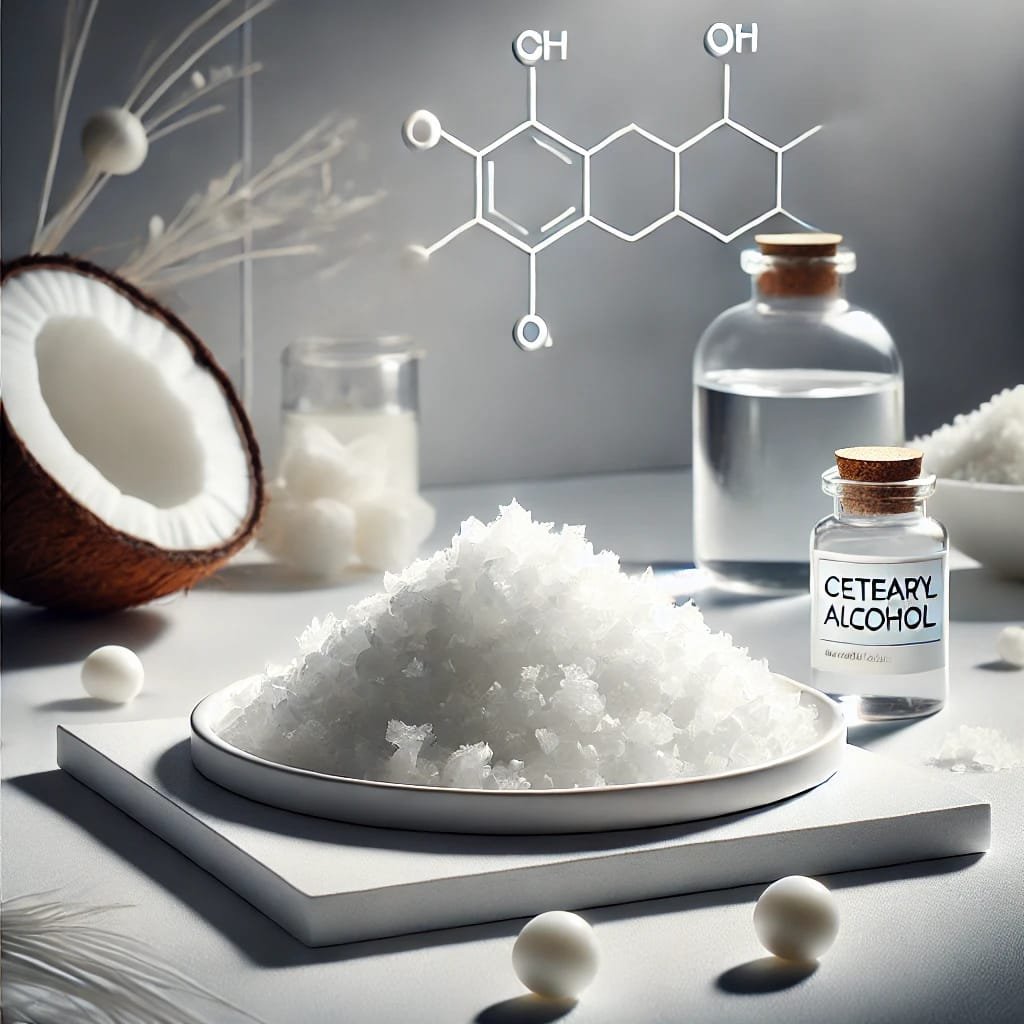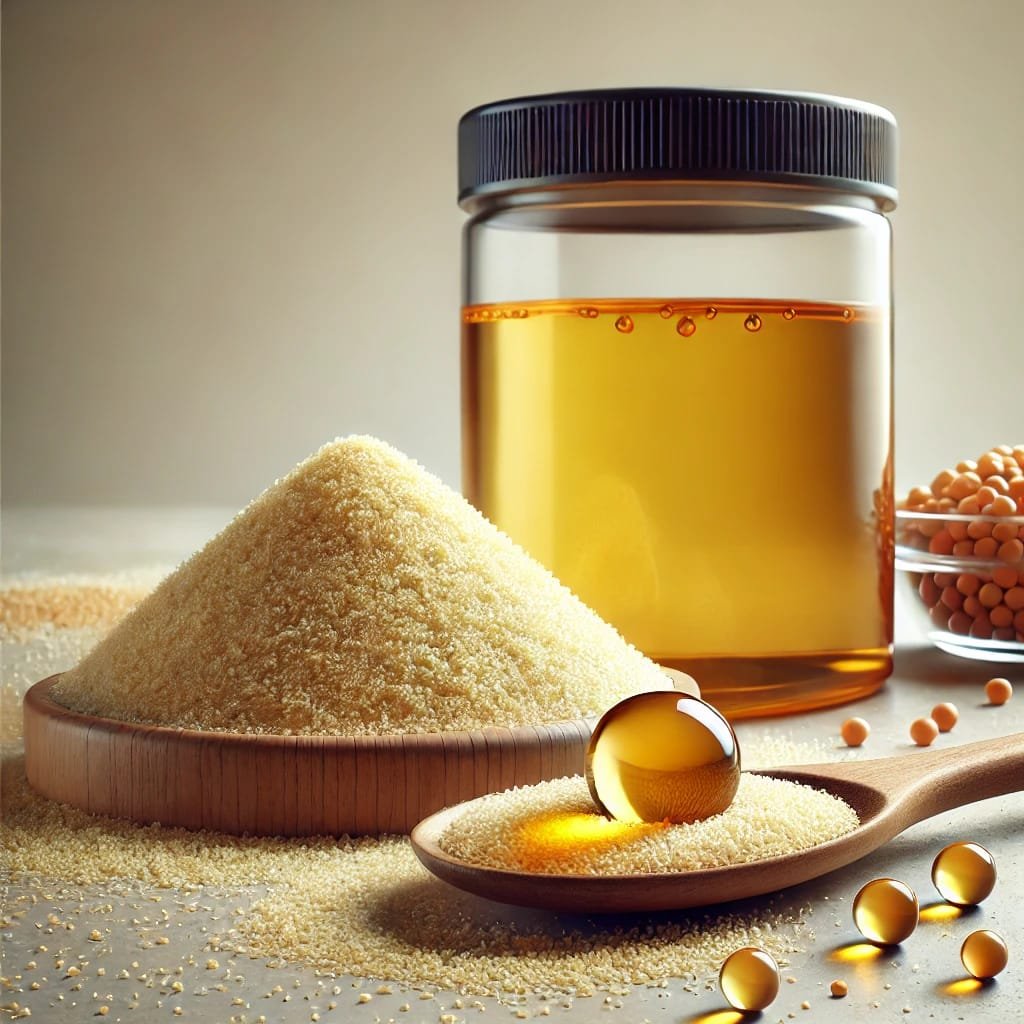INCI name : Glyceryl Stearate and PEG-100 Stearate
CAS number : 31566-31-1, 9004-99-3
A self-emulsifying thickener is a specialized blend of two emulsifiers: glyceryl (mono) stearate (48-52%) and PEG-100 stearate (48-52%). This mixture offers both thickening and solubilizing capabilities, helping to stabilize essential oils in emulsions. The viscosity of the emulsions can be adjusted by increasing the amount of this emulsifier blend. It forms stable emulsions even when high levels of electrolytes are present, and it works well with other emulsifiers of various ionic types.The product typically appears as small whitish pearls or white flakes, and it is odorless. These pearls can be easily dispersed in both water and oil, facilitating the creation of smooth, stable emulsions.
Purpose
The purpose of this self-emulsifying thickener is to efficiently stabilize and blend oil and water-based ingredients in cosmetic and personal care products. It acts as both an emulsifier and a thickener, helping to form smooth, stable emulsions while increasing the viscosity of the product, enhancing its texture. Additionally, it has solubilizing properties that allow it to dissolve essential oils and other oil-soluble ingredients in water-based formulas, preventing separation. This emulsifier is also effective in electrolyte-rich formulations and works well with other emulsifiers of various ionic types, ensuring long-lasting stability and consistency in products like lotions, creams, and serums.

Source Material
Soybean oil is a common vegetable oil derived from the seeds of the soybean plant (Glycine max). It is used as a source of fatty acids, including stearic acid, which is key to the synthesis of glyceryl stearate and PEG-100 stearate.glyceryl stearate and PEG-100 stearate can be considered vegan.
| Feature | Description | Description |
|---|---|---|
| Name | Glyceryl Stearate | PEG-100 Stearate |
| Type | Emulsifier | Emulsifier, surfactant |
| Source | Derived from natural oils or fats (e.g., palm oil or soybean oil) | Synthetic, made by reacting stearic acid with polyethylene glycol |
| PH | 5-7 | 5.5 – 7.5 (in a 3% solution) |
| Concentration | Typically used in concentrations of 1-5% in cosmetic formulations | Used in concentrations ranging from 2% to 8% depending on the formulation |
| Boiling point | 359.40°C | 438°C |
| Color | White to off-white | White to light brown solid |
| Odor | Slight, faint odor | Negligible, faint fatty scent |
| Solubility | Insoluble in water but soluble in oils and fats | Soluble in water and oils; has a hydrophilic nature due to the PEG group |
| Physical state | Solid, waxy | Solid or semi-solid (depends on concentration) |
Method of Obtaining Glyceryl Stearate:
- Glyceryl stearate is synthesized by the reaction of glycerin (also known as glycerol) with stearic acid, which is a saturated fatty acid found in soybean oil (as well as other vegetable oils like palm oil).
- The process involves esterification, where the hydroxyl group (-OH) of glycerin reacts with the carboxyl group (-COOH) of stearic acid, resulting in the formation of glyceryl stearate. This reaction typically takes place under heat and is catalyzed by an acid or base catalyst.
Chemical reaction: Glycerin+Stearic Acid→Glyceryl Stearate+Water
Method of Obtaining PEG-100 Stearate:
- PEG-100 stearate is derived through a process called ethoxylation, which involves the polymerization of ethylene oxide (EO) with stearic acid. This process incorporates ethylene oxide molecules into the fatty acid (stearic acid), producing a hydrophilic polyethylene glycol (PEG) derivative.
- During ethoxylation, ethylene oxide (a small, reactive molecule) is added to stearic acid in the presence of a catalyst, forming a chain of ethylene glycol units attached to the stearic acid molecule. The number of ethylene oxide units in the polymer determines the PEG number, which in the case of PEG-100 stearate is around 100.
Ethoxylation reaction: Stearic Acid+Ethylene Oxide→PEG-100 Stearate
This reaction results in a water-soluble emulsifier with both hydrophobic (fatty acid) and hydrophilic (ethylene glycol) properties, which aids in the formation of stable emulsions in various cosmetic formulations.

Glyceryl Stearate:
Helps Maintain Skin Hydration
Glyceryl Stearate helps maintain skin hydration by forming a barrier on the skin’s surface. This barrier helps reduce moisture loss by preventing water from evaporating, ensuring the skin remains hydrated and moisturized. This is particularly beneficial for individuals with dry or dehydrated skin, keeping the skin supple and refreshed throughout the day.
Acts as an Emollient (Softens and Smooths the Skin)
As an emollient, Glyceryl Stearate softens and smooths the skin. It works by filling in gaps between skin cells, which results in a softer, more nourished appearance and feel. This property makes it ideal for use in products designed to smooth rough or dry skin, providing a silky texture that leaves the skin feeling soft to the touch.
An Emulsifier (Stabilizes Oil and Water Blends)
Glyceryl Stearate plays a critical role as an emulsifier in cosmetic formulations. It helps blend oil and water-based ingredients together, which are otherwise difficult to mix. By creating stable emulsions, Glyceryl Stearate ensures that the product remains uniform and effective over time, preventing separation of the ingredients.
Stabilizes Emulsions, Making Products Easier to Apply
Glyceryl Stearate stabilizes emulsions, preventing the oil and water components from separating. This stabilization improves the consistency of the product, making it easier to apply evenly to the skin or hair. It ensures that the texture remains smooth, creamy, and consistent from the first use to the last, enhancing the product’s overall usability and performance.
Improves Absorption of Other Ingredients
Glyceryl Stearate enhances the absorption of other active ingredients within the cosmetic formulation. By improving the skin’s permeability, it allows other beneficial ingredients—like vitamins, antioxidants, and peptides—to penetrate more effectively. This makes the active ingredients in the product more efficient and ensures that consumers experience optimal results.
Mild and Non-Irritating (Suitable for Sensitive Skin)
Glyceryl Stearate is known for being gentle and non-irritating, making it ideal for sensitive skin. It is considered mild, reducing the likelihood of adverse reactions such as redness, itching, or irritation. This makes it suitable for products formulated for individuals with sensitive skin or skin conditions like eczema or rosacea.
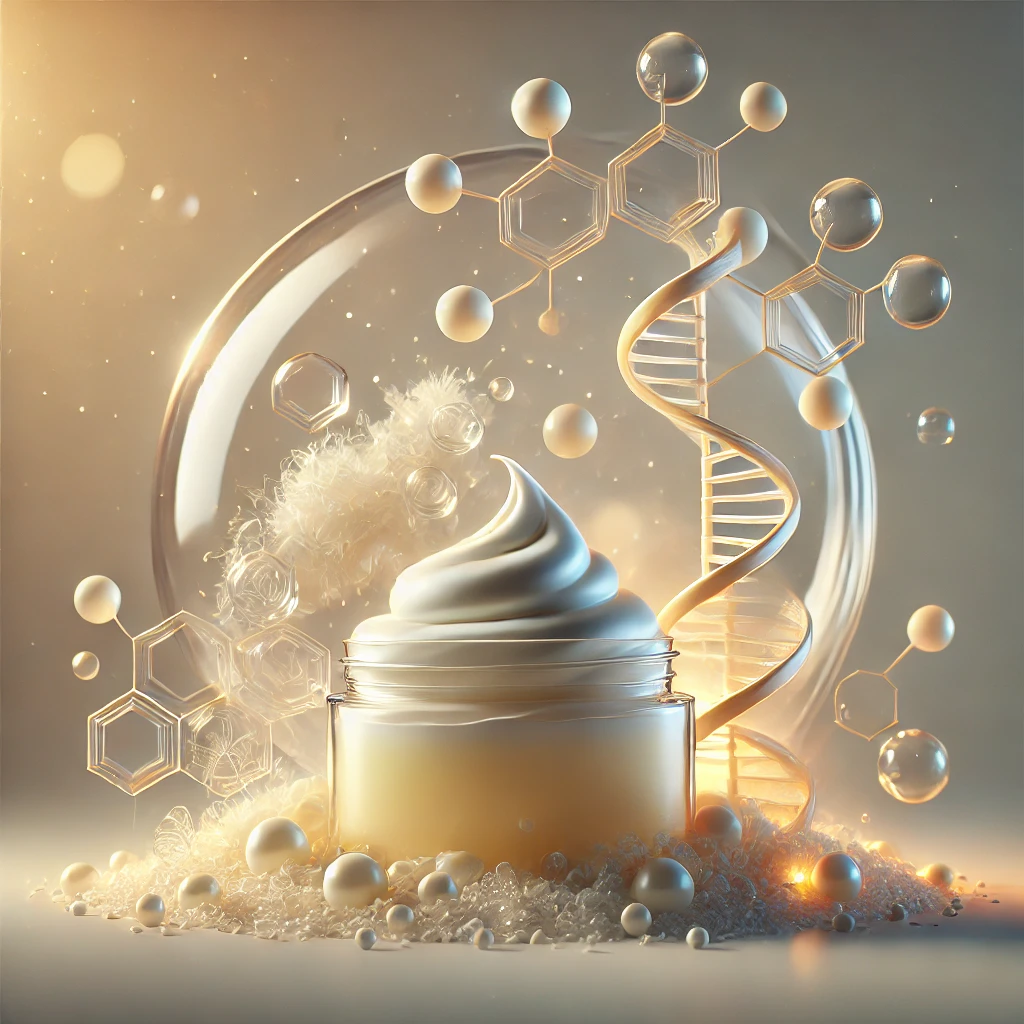
PEG-100 Stearate:
Powerful Emulsifier
PEG-100 Stearate is a highly effective emulsifier, helping to blend water-based and oil-based ingredients in cosmetic formulations. This ability is crucial for creating stable emulsions, such as creams, lotions, and other products where oil and water need to be thoroughly mixed. By ensuring that the oil and water phases are properly incorporated, it creates a uniform product with consistent texture and performance.
Prevents Ingredient Separation
By acting as a stabilizing agent, PEG-100 Stearate prevents the separation of ingredients in emulsions. This ensures that the product remains homogeneous over time and throughout its shelf life, which is vital for maintaining product quality. It prevents oil droplets from floating to the top and water from settling at the bottom, which could otherwise cause instability and uneven distribution when applied.
Enhances Ingredient Penetration
PEG-100 Stearate helps reduce surface tension, allowing other beneficial ingredients in the formulation to penetrate the skin more effectively. By improving skin absorption, PEG-100 Stearate ensures that active ingredients, such as vitamins, peptides, and antioxidants, can be delivered more efficiently to the skin’s deeper layers. This enhances the overall efficacy of the product and maximizes the benefits it provides to the skin.
Acts as a Thickener
In addition to being an emulsifier, PEG-100 Stearate also functions as a thickener. It helps to modify the viscosity of cosmetic formulations, making them thicker or more fluid depending on the desired texture. This is particularly important in products like creams, lotions, and gels, where the consistency plays a major role in user experience and application ease.
Mild Conditioning Effect on the Skin
PEG-100 Stearate has a mild conditioning effect, helping the skin feel soft and smooth after application. This makes it suitable for formulations aimed at improving skin texture and maintaining skin hydration. The softening properties help the skin feel silky and nourished, creating a pleasant sensory experience.
Stabilizes Cosmetic Formulations and Extends Shelf Life
PEG-100 Stearate plays a crucial role in stabilizing cosmetic formulations, ensuring that they maintain their effectiveness and appearance over time. By preventing ingredient separation and reducing degradation, it extends the shelf life of products. This stabilization ensures that active ingredients retain their potency and that the product continues to perform as intended throughout its use.
Safe and Non-Irritating
PEG-100 Stearate is considered a safe cosmetic ingredient with a low risk of skin irritation. It is often used in formulations for sensitive skin types and is generally well-tolerated, provided it is used within recommended concentrations. Its mild nature makes it suitable for individuals with delicate skin or those prone to irritation from harsher ingredients.
Biodegradable and Eco-Friendly
PEG-100 Stearate is a biodegradable ingredient, making it a desirable choice for consumers seeking eco-friendly cosmetic options. As it breaks down naturally, it poses less environmental impact compared to non-biodegradable substances. This aligns with growing consumer demand for sustainable and environmentally responsible beauty products.
Synergistic Effect with Glyceryl Stearate
When combined with Glyceryl Stearate, PEG-100 Stearate acts synergistically, enhancing the overall performance of cosmetic products. Together, they improve texture, stability, and spreadability, making the product easier to apply and more pleasant to use. This combination is ideal for products where optimal emulsion stability and user experience are key, such as moisturizers, sunscreens, and hair conditioners.

Applications of Glyceryl Stearate and PEG-100 Stearate:
Both Glyceryl Stearate and PEG-100 Stearate are widely used in the formulation of various cosmetic products due to their unique properties as emulsifiers, stabilizers, and skin conditioners. Below are the detailed applications for each ingredient across a broad range of cosmetic and personal care products.
Face Creams
- Glyceryl Stearate: In face creams, Glyceryl Stearate helps to blend oil and water, ensuring that the formulation remains smooth and stable. It provides hydration and acts as an emollient, leaving the skin feeling soft and moisturized. Its mild and non-irritating nature makes it ideal for sensitive skin.
- PEG-100 Stearate: PEG-100 Stearate stabilizes emulsions and ensures uniform texture in face creams. It enhances the absorption of other active ingredients and helps the cream spread easily over the skin, improving its efficacy. Its conditioning effect softens the skin after application.
Body Lotions
- Glyceryl Stearate: In body lotions, Glyceryl Stearate helps to lock in moisture and prevent dehydration by forming a barrier on the skin. It also ensures the smooth application of the lotion by stabilizing the water-oil mixture.
- PEG-100 Stearate: PEG-100 Stearate helps to emulsify the water and oil components in body lotions, preventing separation. It also enhances the viscosity, ensuring that the lotion has the right thickness for easy application. Its ability to improve the penetration of active ingredients contributes to better skin nourishment.
Shampoos
- Glyceryl Stearate: Glyceryl Stearate is used in shampoos to improve texture and prevent separation of ingredients. It helps create a smooth, uniform consistency, allowing the shampoo to be evenly distributed through the hair. Additionally, it provides conditioning properties to enhance the feel and manageability of hair.
- PEG-100 Stearate: PEG-100 Stearate serves as an emulsifier in shampoos, ensuring that the product remains stable and does not separate into phases. It helps in mixing surfactants with water and oils, ensuring a smooth texture and enhancing the overall spreadability of the product. It can also contribute to improved foam quality and smoother hair post-wash.
Hair Conditioners
- Glyceryl Stearate: Glyceryl Stearate works as an emulsifier in hair conditioners, helping blend water and oils effectively. It also adds emollient properties to the formulation, leaving the hair soft and hydrated. It helps to improve the overall smoothness and manageability of the hair after conditioning.
- PEG-100 Stearate: PEG-100 Stearate provides the necessary viscosity and stability to hair conditioners. It ensures that the conditioner stays homogenous and does not separate over time. It also supports the penetration of conditioning agents into the hair, improving overall softness and shine.
Lip Balms
- Glyceryl Stearate: Glyceryl Stearate is used in lip balms to provide smoothness and prevent the lip balm from separating. It enhances the product’s emollient properties, ensuring the lips remain moisturized and soft. It also helps the lip balm to spread evenly.
- PEG-100 Stearate: PEG-100 Stearate enhances the texture of lip balms and helps in mixing oils and waxes. It provides additional thickening and ensures that the balm glides smoothly on the lips. It also plays a role in improving the absorption of moisturizing ingredients into the skin.
Sunscreens
- Glyceryl Stearate: In sunscreens, Glyceryl Stearate acts as an emulsifier, ensuring the stability of the water and oil phases. It helps to stabilize sunscreen formulations, preventing the separation of active ingredients like UV filters. Its ability to improve the spreadability of the sunscreen ensures even coverage.
- PEG-100 Stearate: PEG-100 Stearate is used to enhance the texture and uniformity of sunscreens. It helps emulsify the active ingredients and other components, ensuring consistent application. It also improves the penetration of sunscreen agents, ensuring better protection against UV rays.
Facial Cleansing Products
- Glyceryl Stearate: Glyceryl Stearate is utilized in facial cleansers to emulsify the oil-based and water-based ingredients, ensuring that makeup and impurities can be easily removed without causing irritation. It also helps maintain the cleanser’s texture and stability.
- PEG-100 Stearate: In facial cleansing products, PEG-100 Stearate improves the consistency and thickness, ensuring a smooth application. It also helps in dispersing the active cleansing agents uniformly, improving the effectiveness of the cleanser while making it gentle on the skin.
Hand Creams
- Glyceryl Stearate: Glyceryl Stearate is often used in hand creams to provide long-lasting hydration and softness. It helps in forming a barrier on the skin, locking in moisture and preventing dryness. It also helps to stabilize the hand cream’s texture.
- PEG-100 Stearate: PEG-100 Stearate ensures that hand creams remain stable and smooth, preventing ingredient separation. It also contributes to the cream’s thickness, making it easy to apply, while helping to soften and condition the skin.
